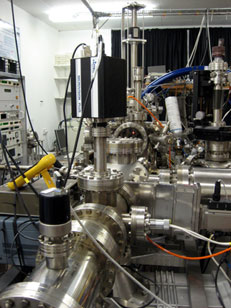The magnetic building blocks of nanotechnology
Posted on 16 November 2009
Scientists are using highly specialised equipment to study the properties of magnetic nanoclusters. These tiny particles typically consist of between 10 and 10000 atoms and have attracted a great deal of interest because of their potential application in a variety of fields of nanotechnology.

Due to their size, the particles have enhanced magnetic properties which may benefit the magnetic recording industry. They also have applications in medicine as they are small enough to pass through cell membranes and travel along capillaries in the body. This opens up the possibility of drug-doped magnetic nanoparticles being used in targeted treatments in, for example, cancer therapy.
The research is a collaboration with the Department of Physics at Leicester University, the York-JEOL Nanocentre and the York Institute for Materials Research.
The Leicester University Mesoscopic Particle Source, or LUMPS (pictured), has been transported to York and attached to an existing large facility run by York’s Nanophysics Group so that a variety of techniques can be used to study the surface of iron nanoparticles.
At the nanoscale it is the surface of a material that determines its properties and so it is essential to be able to study it in isolation. Most techniques that attempt this look at the interaction of the surface with a beam of photons or electrons. However these particles penetrate beneath the top few atomic layers so that the useful information is mixed up with that originating from inside the material.
The York instrument - the only one of its kind in the UKI - is unique as it uses a beam of helium atoms as a probe which greatly increases the surface sensitivity. LUMPS enables magnetic nanoparticles to be deposited directly into this apparatus to allow their properties to be investigated.


Early results show that LUMPS is capable of producing iron particles that are either spheroid or cuboid in shape (pictured). These images were obtained using a transmission electron microscope at the York-JEOL Nanocentre and show individual atoms within the particles as well as the formation of iron oxide (rust) around their edges. A typical iron nanoparticle measures approximately 10 nanometres across.
Future work will see the study of 'nano-onions' which consist of iron particles encased in other materials such as gold.
About the researcher
Dr Andrew Pratt is a Research Fellow in the York Institute for Materials Research
Contact
Email: ap140@york.ac.uk
www.york.ac.uk/res/yimr/index.htm
Further information
- York Institute for Materials Research
- The York JEOL Nanocentre
- York Nanophysics Group
- Study in the Department of Physics
